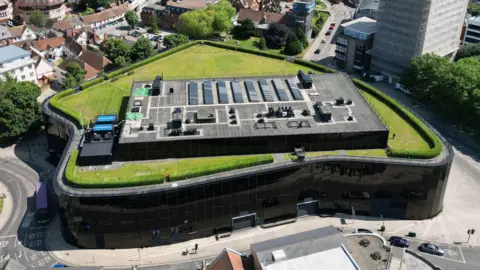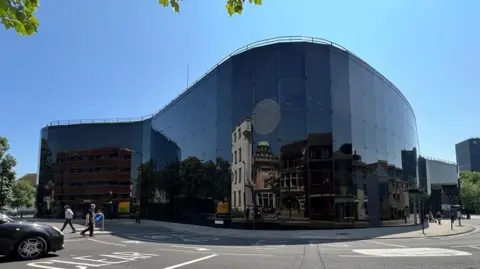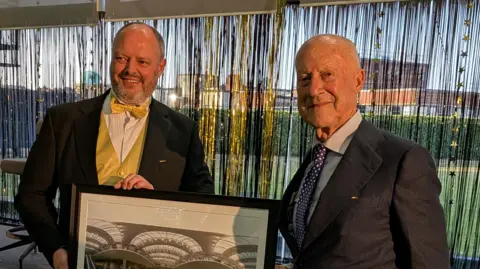'Glass building revolutionised future of offices'
 Stuart Howells/BBC
Stuart Howells/BBCOne of Britain's most renowned architects said a building he designed for an insurance company revolutionised office buildings.
The all-glass exterior Willis building opened in Ipswich in 1975 with a roof-top garden and swimming pool.
It was one of the first buildings designed by Lord Norman Foster who is also the architect behind other buildings such as London's Gherkin and Millennium Bridge.
Lord Foster recently met with superfan Nicola Drown where he shared stories of designing the building which he called a "groundscraper".
"Ipswich is a market town and everybody assumed that [the] Willis [building] would end up being a tower," Lord Foster explained.
"If you think about the essence of Ipswich, it's these winding streets, it's a medieval geometry, so the idea was of recreating the street by following the edge of the site and keeping a building low and respecting the horizontality.
"That was really radical and it gave rise to a new kind of building that was called the groundscraper, as opposed to the skyscraper.
"That was subsequently adopted by developers."
 Stuart Howells/BBC
Stuart Howells/BBCLord Foster, who recently turned 90, said he was still continuously on the go, often attending meetings and talks, including an event at the Willis building to talk about it on its 50th anniversary.
 WTW
WTWLord Foster added the building was a "complete reinterpretation of the workplace" as it was a "lifestyle building", with a roof garden and swimming pool as well as its openness and swathes of natural sunlight inside.
The colour scheme inside the building is yellow and green - colours of Norwich City Football Club, rival of local team Ipswich Town, whose stadium is just across the way.
Lord Foster said he "had no idea" about this when designing the building, however.
Another interesting piece of the building's history included that Lord Foster was "apprehensive" about its height.
He initially got his design team to draw it up as a four-storey building, despite knowing it would never be approved.
"The first thing I got [a designer] to do was two drawings of the outside of the building," he explained.
"One was four-storey and one was three-storey.
"The first submission that I made was for the four-storey and the reaction that I got, that I had anticipated, was that it was too big.
"So we reduced it. We never intended it to be four-storey, but I remember that was a ploy at the time."
Follow Suffolk news on BBC Sounds, Facebook, Instagram and X.
